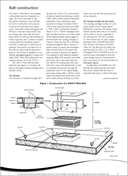1) Focus
Fundamentally, rafts give your mink control a clear focus and direction. Imagine you are setting mink traps without rafts. How many traps do you need? What is the best kind of site? For how long should you run each trap? If you catch nothing, should you stop trapping for a while, or should you move the trap?
These are difficult questions but with rafts, they are almost irrelevant. Thanks to the research that underpins the mink raft approach, you can start with a near-optimal raft density, use the minimum number of traps and will rarely be in doubt about what to do next.
2) Scaled-down trapping
Whereas conventional trapping requires one trap per site, the use of rafts requires a lower number of traps to be available for use and for a far shorter time. The use of traps is therefore vastly scaled down, and so are all the attendant costs: the need to check traps daily, the capital cost of traps, the ecological and animal welfare cost to non-target species.
3) Reduced manpower/effort
Traps must be inspected daily while set, so using traps speculatively (ie. running them in likely-looking spots) can be very time-consuming. Rafts can be inspected at a much longer time interval while they are
simply collecting evidence of mink. Only where a raft collects evidence of recent mink visits is it necessary to set a trap and check it daily. So rafts save on manpower chiefly because they focus where and when to invest your trapping effort. Manpower is also saved by increased trap efficiency (see below).
Of course, the rafts themselves are an additional cost over and above the cost of traps. Against this, you don’t need so many traps. For home construction, the rafts themselves cost approximately £31 each in materials (£51 if you cost in your time), at 2013 prices. A ready-made raft supplied in kit-form costs
about £60 (Perdix Wildlife Supplies). For comparison, the cost of spring traps is about £10, and cage traps £23. A cost comparison of conventional trapping versus the raft system will depend on which type of trap is used, and at what density. Nevertheless, because manpower is the greatest expense in mink trapping, there is a net financial saving in most UK situations.
4) Increased trap efficiency
Because traps are set only on rafts shown to be in current use by mink, captures happen quickly (usually within a few days of trap placement), and thus traps are deployed for a shorter time. Field experience also suggests that rafts are typically much better trap sites than conventional land sets.
5) Reduced non-target captures
Because fewer traps are used, and because they are set for shorter periods, the risk of non-target captures is greatly reduced. Strictly terrestrial non-targets are avoided. Additionally, locations in frequent use by non-target species can be avoided after a short period of monitoring. Movement of a raft by as little as 50m can avoid a water vole colony without affecting the chance of mink captures.
6) Feedback and motivation
There is nothing like a mink footprint to excite fieldworkers and if your mink control is working, the number of rafts with evidence of mink should be falling rapidly. The evidence that this is the case is hugely motivating to fieldworkers, managers and funders alike.
7) Detecting remaining or replacement animals after successful removal by trapping
All culling will have some impact on mink population size, but ecological consequences may perhaps be trivial if some mink are still present after trapping, or if removed animals are quickly replaced through reproduction or immigration. As yet, we don’t know what level of mink abundance – if any – is low enough to allow persistence of different prey species. In the absence of such knowledge, the aim of most control efforts is currently to ensure complete absence of mink on a local or wider scale. The GWCT Mink Raft provides a method of monitoring presence or absence of mink at specific sites that is independent of the trap itself. In pre-existing trapping strategies, the continued presence of mink at removal sites (or elsewhere) could be monitored only by field signs, direct sightings or further trapping. All of these are less sensitive than the raft method.
Get your FREE Mink Raft Plans today
 The award-winning GWCT Mink Raft was developed both as a means of detecting mink, and as a favourable trap site.
The award-winning GWCT Mink Raft was developed both as a means of detecting mink, and as a favourable trap site.
What you can download for free
✓ Mink Raft Guidelines
✓ Instructions & Plans
✓ How to Build the GWCT Mink Raft
Download now >